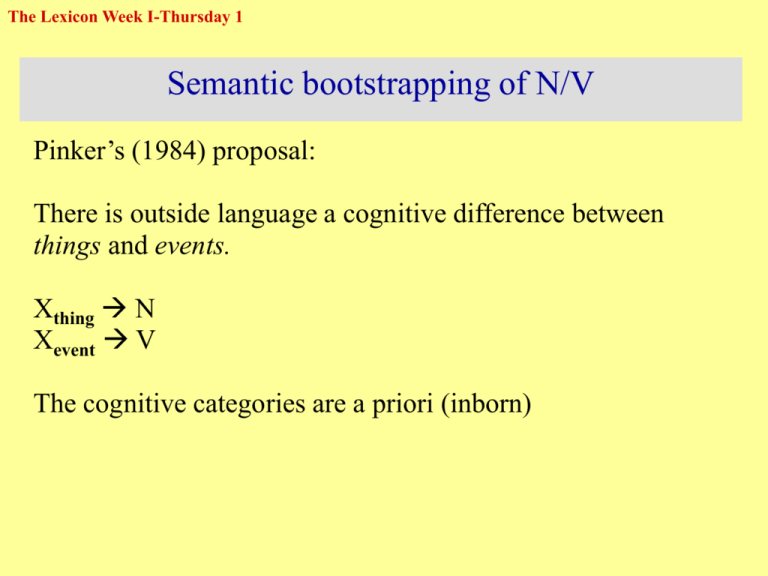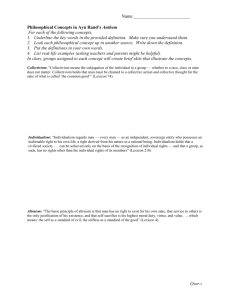Power point slides
advertisement

The Lexicon Week I-Thursday 1 Semantic bootstrapping of N/V Pinker’s (1984) proposal: There is outside language a cognitive difference between things and events. Xthing N Xevent V The cognitive categories are a priori (inborn) The Lexicon Week I-Thursday 2 The distinction N/V Suppose all grammar of English were ‘inborn’ due to the beautiful genetics of the English race. a priori to be assigned to strings of English distinctions One would still need to learn how to apply these distinctions to the actual form. It is like knowing all names and addressees in the telephone book, but not knowing the numbers. If you buy this argument, you will not expect much from a priori schemata. UG, even if ‘inborn’ for the human race, would still need an acquisition procedure. The Lexicon Week I- Thursday 3 Difficulties with Pinker’s way Xthing N Xevent V I. Many words in English can appear as a N V a walk to walk drink drink sleep sleep run run II. There are nouns for events a walk, a drink, etc.. and verbs for states to know, to sit, to stand, to live, etc.. Hence there has to be a moment when N and V are assigned for reasons of grammar rather then for reason of cognition The Lexicon Week I- Thursday 4 The grammatical way for N/V the sleep N / this — that (sleep) his any Do In general: XN/D— XV/I— sleep V / to — — ing (sleep) —s may — Io The Lexicon Week I- Thursday 5 Syntactic bootstrapping Van Kampen (1997, 2001) Alternative approach to the N/V category distinction The first syntactic constructions in child language consist of two word utterances utterance operator content sign (characterizing X) wish wanna mouse command more play(ing) constative that/is on denial no nice utterance topic (naming X) bunny girl shoes doggie comment (characteriz.X) dance(-ing) bad off girl The Lexicon Week I- Thursday 6 Syntactic bootstrapping (Van Kampen 1997) Content signs X can be used in two functions a. <naming> X (bear !) (quasi-proper name) b. <characterizing> X (bear !) (is a bear) The switch is a matter of pragmatic intention. There is no grammatical context that would force category assignment N, V, A The Lexicon Week I- Thursday 7 Grammatical marking <Characterizing> is a kind of proto-predication (Lyons 1976) The adult input marks the characterizing function by Io IP <+pred> Io is X bear climbing away bad The whole is labeled IP, because - the topic may be left out - the Io indicates the function of the full phrase The Lexicon Week I- Thursday 8 Grammatical marking The grammatical marking by - Io for characterizing - Do for naming establishes the subject-predicate construction IP DP the/a/my <+D> IP X bear is <+I> Y dancing The Lexicon Week I- Thursday 9 The grammatical way for N/V I-marking for characterizing phrases D-marking for naming phrases are the first major steps in acquisition Io = some copula; an auxiliary or verbal inflection Do = some article; a demonstrative or nominal inflection are accomplished before the 3rd year are easily followed by the distinction V/N XN/D— XV/I— The Lexicon Week I- Thursday 10 Generalization The cues for - stress assignment - category assignment operated in a local, binary context their frequency can be established quantitatively each cue forces an immediate well-formedness constraint (stress left; add Do or Io) The cause/cue, the order and the speed of the learning steps can be established by a longitudinal method




